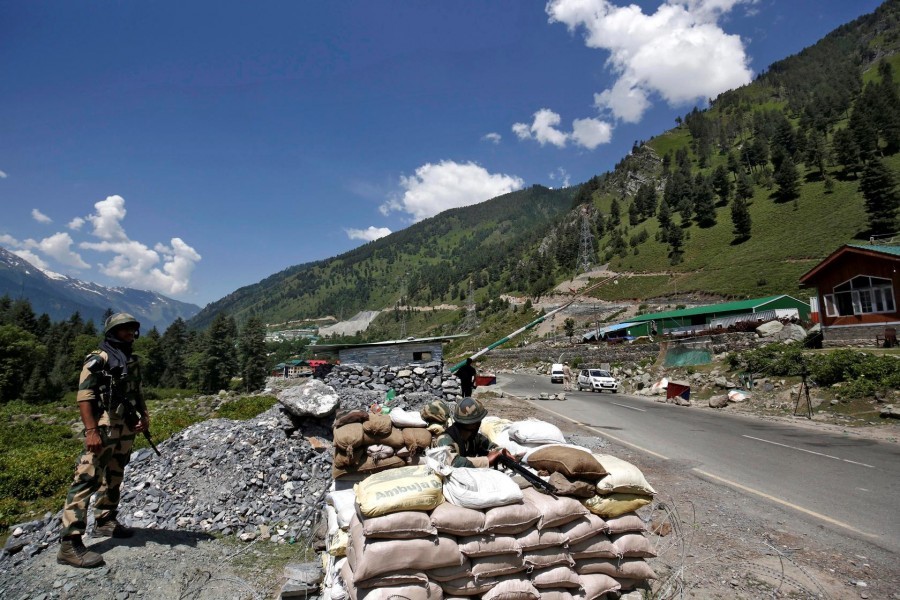India and China continue to build roads in the remote Himalayan region blocking the road to peace between the two countries, says an article in South China Morning Post (SCMP).
“Border talks between China and India have stalled, with road-building in the remote Himalayan region a key sticking point,” says the article by Keegan Elmer entitled “China and India’s road to peace blocked as both sides build in border region”, referring to analysts.
Referring to foreign ministry officials from both China and India, it adds that progress was made during last week’s round of talks, with agreement to continue the disengagement of troops.
But progress has been slow in this area since a deadly mid-June clash in the Galwan Valley which left 20 Indians dead and an undisclosed number of Chinese casualties, according to the article.
Meanwhile, Indian news reports indicated tensions remained high, with roads in the mountainous region a main point of contention.
The Hindustan Times reported talks had broken down because China insisted on an equal rearward movement by both militaries.
Citing an Indian government source, the report said India had rejected this position, because the Chinese had better roads, making it faster and easier for them to approach conflict zones, according to the SCMP article.
On Thursday, the same newspaper said India had drastically increased funding for strategic border road building and maintenance in the region since June, from US$46 million to US$60 million in the current financial year. Road maintenance funding has soared since June, up from US$4.1 million to US$30 million, it adds.
The development of roads and other infrastructure was a key cause of the Galwan Valley incident and is likely to cause future problems as India pushes to build up its transport links, the article says quoting an Indian university professor.
“China has been building up roads and railways through Tibet for years, and India has recently ‘woken up’ to the lack of infrastructure on its side,” Srikanth Kondapalli, professor of Chinese studies at Jawaharlal Nehru University in New Delhi. was quoted as saying in the SCMP article.
Both sides have been developing infrastructure on their respective sides of the contested border region in the vast, desolate and mountainous terrain between China’s Tibet autonomous region and India’s union territory of Ladakh.
China’s national highway 219 runs 10,000km (6,200 miles) along its entire southern and western border, from Guangxi Zhuang autonomous region, through Chinese-controlled Aksai Chin and on to western Xinjiang. Meanwhile, India last year completed a key 255km stretch of road running parallel to the Line of Actual Control and passing close to the Galwan River valley where the deadly fighting occurred.
The building of Indian “feeder roads” and bridges stretching from the main road toward the disputed areas in the days leading up to the June clashes was the key trigger for the conflict, according to him.
Indian media reported this week that New Delhi had decided to press ahead with a strategic all-weather route from the northern state of Himachal Pradesh to Leh in Ladakh, which would speed up India’s capacity.
“Neither side is being fully transparent about the details of the conflict on the ground. But the building of roads is one of the few things we can see,” The SCMP article quotes Claude Rakisits, an associate professor at the Australian National University’s Asia-Pacific College of Diplomacy, as saying.
“In general, India has the right to build roads just like everyone else, but if your neighbour could use its roads to transport troops, they are more than just simply roads,” he said.
On Thursday, the Chinese defence ministry said the two sides had made progress through their military and diplomatic talks since the Galwan Valley clash. Spokesman Colonel Wu Qian said China expected India to work with it towards the same goal, and that they should “avoid misjudgment”.
Indian Foreign Minister Subrahmanyam Jaishankar warned that tensions at the border remained at their highest since the China-India border war of 1962. In an interview with Indian online portal Rediff.com, he said there was an “unprecedented”number of troops deployed on both sides.
Tens of thousands of troops are believed to have been stationed on both sides of the border since June.
In an interview with Indian news agency ANI, Indian chief of defence staff General Bipin Rawat said on Monday that “the military options to deal with transgressions by the Chinese army in Ladakh are on”, if diplomatic and military talks failed.
Amarinder Singh, chief minister of the northern state of Punjab, told Indian media on Wednesday that the country must strengthen its military to deal with encroachment from China. “I think you can put a stop to this only when we can deal with them militarily,” he said.


